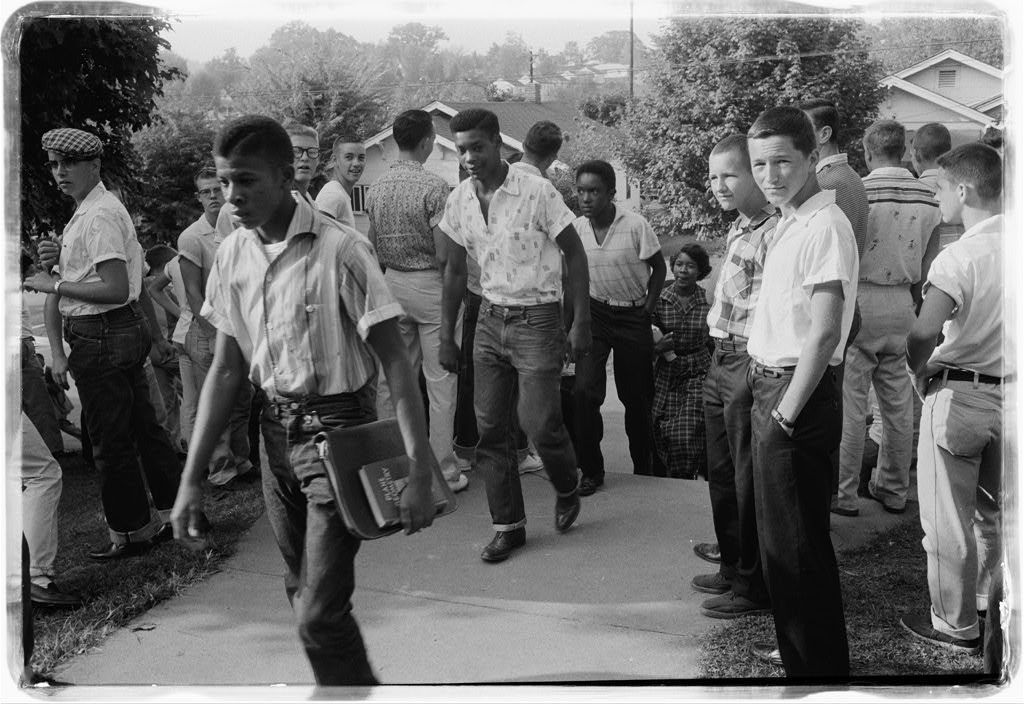.

"Don't work" sign promoting a holiday to honor the anniversary of the assassination of Martin Luther King, Jr., on a shop on H Street, N.W., Washington, D.C.: photo by Marion J. Trikosko, 3 April 1969

Birmingham, Alabama: average Negro homes: photo by Marion J. Trikosko, 14 May 1963

Group of African Americans viewing the bomb-damaged home of Arthur Shores, NAACP attorney, Birmingham, Alabama: photo by Marion S. Trikosko, 5 September 1963

Bomb-damaged trailers at the Gaston Motel, Birmingham, Alabama: the wreckage of a bomb explosion near the Gaston Motel where Martin Luther King, Jr., and leaders in the Southern Christian Leadership Conference were staying during the Birmingham campaign of the Civil Rights movement: photo by Marion J. Trikosko, 14 May 1963

Riot damage in D.C.: the ruins of a store in Washington, D.C., that was destroyed during the riots that followed the assassination of Martin Luther King, Jr.: photo by Warren K. Leffler, 16 April 1968

Washington D.C. riot, April '68, Aftermath: members of the D.C. National Guard patrolling streets as pedestrians walk by: photo by Warren K. Leffler, 8 April 1968

Montgomery, Alabama: four African American students speaking to a white reporter on Alabama State College on campus: photo by Thomas J. O'Halloran, 10 March 1960

Integration at Ole Miss[issippi] Univ[ersity]: James Meredith walking to class accompanied by U.S. marshals: photo by Marion S. Trikosko, 1 October 1962

Clinton, Tennessee school integration conflicts. (Photographer's note: "A line of African American boys walking through a crowd of white boys during a period of violence related to school integration."): photo by Thomas J. O'Halloran, 4 December 1956

African American school children entering the Mary E. Branch School at S. Main Street and Griffin Boulevard, Farmville, Prince Edward County, Virginia. (Photographer's note: "Farmville, Prince Edward County, Va., 'Free' schools open. Children arriving, opening ceremony, flag raising and assembly at Free School #2. Mary E. Branch School is the second Robert R. Moton school built 1939 on S. Main Street and Griffin Blvd. assoc. with desegregation."): photo by Thomas J. O'Halloran, 16 September 1963

School integration. Barnard School, Washington, D.C.: photo by Thomas J. O'Halloran, 27 May 1955

A crowd of African Americans behind a storm fence with police on the other side at Civil Rights march on Washington, D.C.: photo by Marion J. Trikosko, 28 August 1963
Photos from U.S. News & World Report Magazine Collection, Library of Congress



6 comments:
These photographs touch very very deeply a sore tender place that seems to never properly heel.
The O'Halloran photos - the picture of the young men walking the gauntlet and the body language of the two young white boys on the right, seemingly that of 40 or 50 year old men, is every bit as frightening as is the Barnard school picture of the young girls touching. There is so much here and so much that is really difficult to look at, to concentrate on.
Almost too much to bear. Thank you for these. Don
Thanks, Don. For whatever night-busride reason it seemed the right time to pause and dwell on this moment of the past -- is it gone? -- or is it just that maybe people more than ever need reminding?
Is it gone? Oh, we wish. I remember not too many years ago a front page story here quoting a woman just north talking about Klan activity. They haven't gone away, she said, just harder to spot since they don't wear the white sheets anymore.
And, as you know, I appreciate an economy of words and the your title, Movement, seems to me a one word poem.
Don,
I guess I felt that, if racial hatred, discrimination and prejudice were actually gone, there would have been no need for such a post.
But alas, white sheets or no, it's very hard to avoid seeing the (faint?) traces of something old and scary under the superficial rhetoric directed against our current President by many who, one suspects, just can't adjust to the idea that the White House might be occupied by anybody other that a 100% white person.
Tom:
Yes, it's not very far below the surface, certainly. The human race is such a strange, sad strain of life.
Given the ability to be self reflective, we simply look in the mirror instead.
The post is very much appreciated ...
As is your noticing and being stirred by it, my friend.
(This is why we keep on...)
Post a Comment